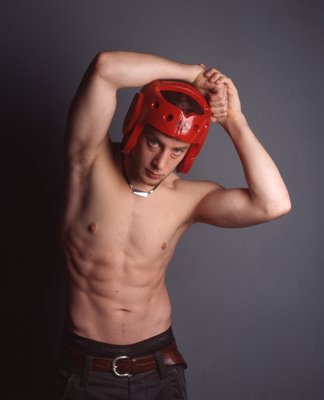Christopher Gaze - From Richard III To King Lear & Back
Saturday, September 27, 2008
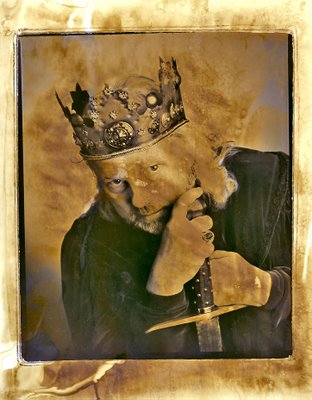
Last night Rosemary, Abraham Rogatnick and I went to the last performance of Bard on the Beach's production of William Shakespeare's
King Lear with Christopher Gaze as Lear. Of Christopher Gaze as Lear I first wrote
here.
As I prepared today and looked for the images I was going to use for this blog I was troubled with a melancholy that came to me for several reasons. As I look out the window our garden is decaying and the hosta leaves no longer look pristine in their greeness, blueness or goldness. Yellow is beginning to creep in on them all. The buds of some of my roses will not open and I think of them as potential beauty cut short by the season in much the way as that of a young woman or man cut short in the prime of life. Certainly it is the stuff to precipitate melancholy.
But there is a more important reason for it all. Somehow in all of my 66 years I never attended a performance of King Lear. Nor would I have ever suspected that I would do so with a loving friend who is of the same age as the Shakespearian King Lear. Not only that but Abraham Rogatnick (86) knows most of the lines of the play by heart. I watched him smile at Christopher Gaze's exquisite performance (on a wheel chair). With his usually neat hair combed, askew in every direction, I was watching the decay of time made worse by Rogatnick's confirmation of Gaze's accurate inerpretation. Watching Gaze lapse into insanity and ramble on I could see elements within myself. Will I become the role model of old age that Rogatnick embodies for me or will I become the foolish man of Shakespeare's play?
It didn't take me long to understand that the tragedy of the play hinges on a young woman's reticence to openly declare her love for her father. My mother died without me ever telling her so. Was my mother more prescient in understanding my reluctance to be vocal? My father and I understood our mutual love for each other without words. I believe he knew of it when he died. Yet my mother often told me, "Love, Alex is not saying but doing."
After both of King Lear's older daughters, Goneril and Regan, vocalize their love for their father upon his request, Lear says to his favourite, Cordelia:
...what can you say, to draw a third more opulent than your sisters? Speak.
Cordelia: Nothing my lord.
Lear: Nothing?
Cordelia: Nothing.
Lear: Nothing will come of nothing: speak again.
Cordelia: Unhappy that I am, I cannot heave my heart into my mouth: I love your majesty according to my bond; no more no less.
Lear: How, how Cordelia! mend your speach a little lest you may mar your fortunes.
Cordelia: Good my lord, You have begot me, bred me, lov'd me: I return those duties back as are right fit, obey you, and most honour you. Why have my sisters husbands, if they say they love you all? Haply, when I shall wed, that lord whose hand must take my plight, shall carry half my love whith him, half my care and duty: sure I shall never marry like my sisters, to love my father all.
Lear: But goes thy heart with this?
Cordelia: Aye, my good lord.
Lear: So young and so untender?
Cordelia: So young, my lord and true.The tragedy then unfolds because of this misunderstanding. It would seem that Lear and my mother were at odds. Love sometimes is saying and not doing. Cordelia is banished and disinherited.
Watching Lear destroy his family (did he destroy his once mentioned dead wife? Of this we do not know), I felt a fear as my daughters become older and my eldest granddaughter begins to declare her independence not only from her immediate family but from me. I long for a little phone call, "Hi, papi, this is Rebecca. How are you?" Yes, love, sometimes is saying.
I have written here before on how I had the opportunity to photograph Chistopher Gaze as Richard III in 1984 and again in 1998. It seems appropriate that I first met Gaze when he was a much younger man playing in one of Shakespeare's earlier plays. It further seems appropriate that King Lear may be Gaze's last big part in a Shakespeare play written quite a few years later when Shakespeare's own father had died. As I lisened to Gaze give his company a sweet but melancholy speech backstage last night I kept thinking on how all those elements of my own personal life which had begun coincidentally in 1955 when I lived with my mother and grandmother on Calle Shakespeare in Mexico City had perhaps randomly conspired that I was to see Lear only last night and not before.
The image here of Christopher Gaze as Richard III, which I took in 1998, is a faded b+w photograph that has deteriorated so wonderfully (badly fixed!). It is a photograph that compresses not only Gaze's journey from Richard III to King Lear but also reminds me how much pleasure (and occasional melancholy) Christopher Gaze and his Bard on the Beach have brought to my Most special of all was being able to see King Lear through the eyes and ears of Abraham Rogatnick.
Thinking Inside Of The Box - The Old & The New
Friday, September 26, 2008

I have written
here before how my approach to photography is an awareness and a concern with three dimensions. Today I teach my third class (out of 10) History of Photography at
VANarts. Instead of hearing me in a long three hour lecture I am throwing them into a studio with the idea that they must immerse themselves in the early 19th century of photography. For a week I have been thinking about it and trying to see what 17 students with high-end digital cameras can do. Since some are beginners they still don't know the ins and outs of their equipment.
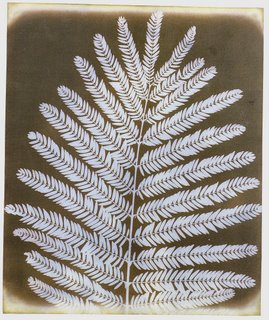
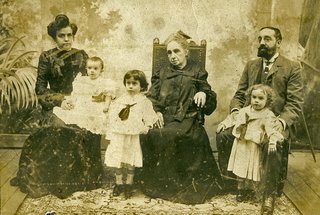
In this blog I have thrown in a mixture of really old family photographs (my family) taken in the 1880s with some old photographs of that century plus some fresh "old" pictures that I fixed up last night as I wrote this. Most of the solutions involved include putting hard copy (photographs on paper) on to my scanner or modifying with colour shifts such as Photoshop sepia toning of regular b+w photographs.
 |
| Captain Beefheart |
But how to do this with a digital camera? Much has been written and said about thinking outside of the box. In this case my students, for some of the tricks, will have to think within the box that is their camera. They will take pictures in a studio without artificial lights. Perhaps they will place their cameras on tripods and try to use very long exposures so that their subjects will stiffen in an effort not to move.
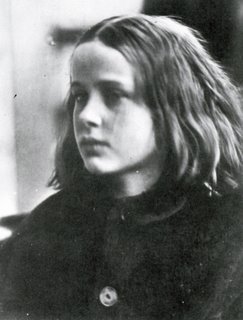 |
| Annie my first success by Julia M Cameron |
I believe that the ultimate palette is limited if all one can do is to work within that photographic box.
 |
| My mother |
After much thought I have found a solution which I will try to impart to my class. Many of my photographs with only small tweaks look like old photographs. Why is this? It has to do with the posing of my subjects. It is important what I ask them to do with their hands and how they stand or sit. The lighting can be modern but the rest borrows from the posing of the 19th century. I will see if this solution is indeed a solution today.
 |
| Rebecca & the agave |
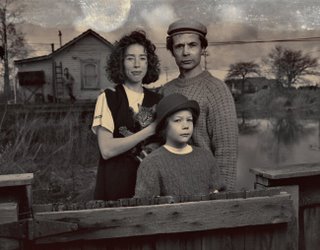 |
| Finn Slough |
Image: Scanned fern, upper left, Alex W-H September 25 2008
Image: My ancestors, Barcelona 1888
Top Right: Botanical specimen, photogenic drawing negative 1839 Henry Fox Talbot
Below left, Captain Beefheart, Alex W-H Vancouver 1982
Below (oval) My mother 1919
Right in b+w: Annie My First Success, January 1865 Julia Margaret Cameron
Below left: Finn Slough, Richmond, Alex W-H 1997
Rebecca and agave, Queen Elizabeth Park, Alex W-H 2004
And last: Guatemalan weavers, María and Dominga, Vancouver, Alex W-H 2002
 |
| Guatemalan weavers |
Murray Pezim, Mr. Poland & No Light Bulb
Thursday, September 25, 2008
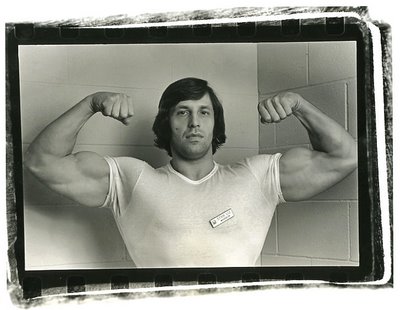
When Murray Pezim (below) died on November 11, 1998 The CBC said in its obituary:
Colourful Vancouver stock promoter Murray Pezim died of a heart attack early Wednesday morning. He was 77 and has been ill for a number of months.
Pezim was once considered the most powerful man on the Vancouver Stock Exchange. At one point his companies were involved in a about a quarter of all trades.
His two biggest gold discoveries were Hemlo in northern Ontario and Eskay Creek in northwestern British Columbia. He was also a former owner of the B.C. Lions football team.
Pezim suffered a heart attack late Tuesday night, and died early Wednesday morning in a Vancouver hospital.Through much of the 70s and 80s I had the opportunity to photograph this man in many locations and under many circumstances for
Vancouver Magazine and many business magazines. When he died the Vancouver Stock Exchange was in its last legs having lost all of its credibility around the world.
David Baines of the
Vancouver Sun and
Adrian du Plessis, a free-lance white collar crime investigator, had put the final nails on the coffin. With the death of Pezim the stock exchange lost all the humor and flamboyance he had contributed to it.
But there are two occasions related to Murray Pezim I will never forget. It has to do with the photograph I almost took and the one I didn't.
In the early 80s Pezim used any ploy to get press space. He sent a press release to Vancouver Magazine that he had hired the former Mr. Poland, Stan Liz to be his personal masseur. Mac Parry dispatched writer Les Wiseman and I to interview and photograph Liz. I told Wiseman that I knew exactly what I was going to do. I was going to ask the man to stand on a chair and hold on to an overhead light bulb. It was going to be a Polish joke. When we got there Liz could barely communicate in English and I realized I would not have any problem carrying out my idea.
Some years later Equity art director Chris Dahl paged me. I found a phone and talked to him. "Alex I want you to photograph The Pez (as Pezim was affectionately known) holding a hanging knot on himself. The story is all about how he has become his worst enemy." I immediately responded, "Sorry Chris I can't. I was a Boy Scout and the one knot I was never allowed to tie was a hanging noose. I will not have any part of this." Not only did I lose the job but I then found out that it had been a cover assignment so I missed out on a good piece of change.
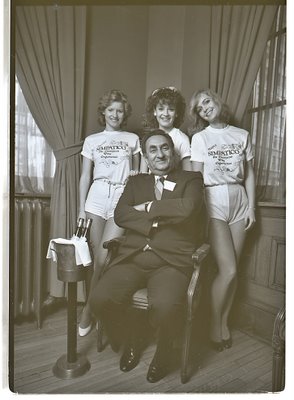
In later years particularly in such publications as Business in Vancouver and the Vancouver Courier there was a run of photographs much like the ones I almost took. I always flinched in embarrassment when I saw them. I felt sorry for the subjects and had little respect for the photographers who showed so little consideration for the human dignity we are all born with.
Perhaps I had indeed learned something while being a Boy Scout.
Addendum:
I dispatched links to this blog to both David Baines and Adrian du Plessis inquiring on my accuracy. Here is one reply:
Dear Alex ~
I believe David is off somewhere, rumour has it, he's spending the reserves in his Cayman accounts. When he checks in, he may have a different view, but, it all looks good to me!
You could describe me as eligible bachelor, music-lover, friend to felines, and other such titles, but, in the context of your blog post, I can't say that the words you've chosen don't fit the bill.
Those WERE the good ol' days in the stock trade. I wonder who's still got a Pez dispenser from Murray...
Sláinte, Adrian
Adrian du Plessis
Allison Crowe Music
(250) 537-1286 www.allisoncrowe.com
"Why music?" "Why breathing?"
And David Baines (Back from the Caymans?) wrote:
Hi Alex:
Your piece brings back warm memories.
When Pezim was on his death bed, I wrote this column (appended). Even though it was a sad occasion, it is one of my favorite recollections of The Pez.
David
Pezim down but certainly not out
The Vancouver Sun
Friday, April 18, 1997
Page: D1 / FRONT
Section: Business
Byline: David Baines, Sun Business Reporter
Source: Vancouver Sun
Tony, the doorman at the Hyatt Regency Hotel, beamed at the mention of his name.
``I know Murray Pezim very well. He's a really neat guy. A real gentleman. He was always very nice to us,'' he said.
Tony says he was one of the first to invest in Pezim's biggest gold find, International Corona Resources, which discovered the Hemlo gold fields. He bought his shares at a buck, and before long, they went to the moon.
Not all Pezim's investors fared so well. I remembered when two young comedians, who were trying to market a board game called Punchlines, visited me at my office and described their experience with Pezim.
One, pretending to be Pezim, draped his right arm over the other and told him how he was going to finance his deal and make him rich. As he was talking, he slipped his right hand into his partner's jacket pocket and quietly relieved him of his wallet.
They laughed at their little skit. Pezim had taken them on a ride to nowhere, but what fun they had had.
Back at the Hyatt, a car pulled up and jazz singer Kenny Colman, a long-time friend and fan of the Pez, waved from the passenger seat. His partner of five years, Lilly Krief, was driving. Tony opened the back door for me and I jumped in. We were going to Murray's world.
``Murray's a throwback, the last of Damon Runyan characters,'' said Colman. ``He's a real Guys and Dolls character. If he wanted, he could have been a movie impresario, like Louis B. Mayer.
``He liked me around because he wanted to meet celebrities. I remember one night when we were at the Desert Inn in Vegas. He told me he wanted to meet Frank Sinatra, so we went back stage and, well -- you know Murray -- I was little nervous about what he would say.''
But Pezim stepped right up to the man they call the Chairman of the Board and said, ``Frank, if I'd met you 25 years ago, I'd have named a gold mine after you.'' In a single brilliant stroke, Pezim had not only made Sinatra feel like gold, he had indelibly impressed himself as the man could actually produce gold. He would not need a second introduction.
``That was Murray,'' said Colman. ``Always promoting. It was never the money, it was always the action. When Murray's not in the action, he's dying.''
The word hung for a split second, then Colman resumed his patter. ``Here's a copy of my CD,'' he said, handing me a plastic-wrapped disc entitled Dreamscape.
``You don't have to mention my name, but if you do, there's no `e' in Colman. And if you don't, please mention the club,'' he said, referring to his jazz club, the Casbah Jazzbah on West Pender.
We were getting close to Murray's world, once riotously populated with movers and shakers and hangers-on.
``There were always these struggling people around him,'' said Colman. ``But they never scored off him. You could never fool him, unless you were some blonde in an elevator.''
Lilly drove the car to Rooster's Quarters on Denman, where she picked some Montreal-style chicken. Then we drove to Pezim's high-rise condo at the foot of Hornby Street, overlooking False Creek.
As we were getting out of the car, Colman warned me Murray's world had changed. ``He wanted to cancel. He said he didn't feel up to it, but I told him he needs to see people.''
A Filipino caregiver answered the door on the 22nd floor. It opened to a fabulous view of False Creek. The furnishings were symmetrically stylish. Very un-Pez like.
The greatest promoter in Canadian stock market history, now 75, was in his bedroom lying on his side. ``David, how are you?'' he smiled. Fine, I said, but how was he?
``I'm a strong son of a bitch. I should have been dead by now,'' he replied.
He dressed. The caregiver helped him into his wheelchair and pushed him to a glass table overlooking the south shore. The sky generously allowed some sun into the room. Lilly, a most gracious woman, fussed with the food. Pezim's left arm lay idle, a casualty of last year's stroke.
``I'm embarrassed that this could have happened to me,'' he said.
``Murray,'' chimed in Colman, ``do you remember when you owned the B.C. Lions and we had Pez Day? When was the last time 40,000 people went to a football game in this town? I sang O Canada that day.''
``That was the worst part it,'' Pezim said, deadpan.
I remembered that day. Pezim's girlfriend, the stunning Tammy Patrick, who he had rescued from a serious cocaine addiction, wore a Lions jersey with No. 4 on it, signifying she was to become his fourth wife. (It didn't happen).
Pezim had also agreed to manage the nascent boxing career of Mark Gastineau, the former NFL football star. (That didn't happen either). Gastineau and actress Brigitte Nielsen temporarily moved in with Murray. Doug Flutie visited Vancouver and woke up in the morning with a hangover from laughing so hard, and a new contract to play with a team he had barely heard of.
Sports Illustrated writer Doug Looney flew to Vancouver to write a story about Flutie, but instead did a hilarious story about The Pez.
Looney followed Pezim to his second home in Scottsdale, Ariz., where he met his maid, ``who looks like no maid you have ever seen before,'' then to his $5.5-million house in Vancouver where he was introduced to Pearl the gardener, ``who looks like no gardener you've ever seen.''
The story was 10 pages in length, an honor the magazine has never bestowed upon any local athlete. ``It's great for the CFL,'' remarked Pezim. ``They tell me they have 79 million f------ readers.''
Robin Leach, the nasal host of Lives of the Rich and Famous, also flew to Vancouver to do a piece on Pezim. The background music was the theme song from Goldfinger.
Pezim reflected on those days. He said the Hemlo discovery was the best time in his career. Then there was Eskay Creek in northern B.C., another big gold find. He created big, rolling markets for his stocks. There was lots of action for everybody.
``David, I've lived a full life. I've done everything I want. I can't say God has been bad to me, but I can yell at him sometimes.''
He says he would prefer to be in the warm climate of Scottsdale, Ariz., his second home, but the medical bills were prohibitive.
``I'll bet in the last three years it has cost me $500,000.''
He says he wants to rally, at least long enough to make a public appearance. ``I really would like to walk down Howe Street. I feel I'm about eight to 12 weeks away.''
He scoffs at the blue-chip pretension that has swept the Street. Speculation has been gussied up and is now assuming the guise of investment.
``It's a totally speculative market,'' he insists. ``The problem is, it's being sold for something different.''
Bre-X Minerals, he says, happened because ``some Eastern guys took over this junior market and added a couple of zeros to it.''
Asked about his son, Dr. Michael Pezim, who took control of his flagship company, Prime Equities International, he said, ``His view of how to run the company is different from mine, but he can have his opinion.''
He once spent his days scanning a battery of quote terminals, but there is not a single machine in his apartment. ``The market is behind me now, but I do miss it. If I had the right ingredient. . . .''
Colman starts singing the words to the old Duke Ellington song, Satin Doll: ``Cigarette holder, which wigs me. . . .''
Pezim joins in: ``Over her shoulder, she digs me. Out cattin', my satin doll.''
They laugh. Forty-five minutes has passed. Pezim says he doesn't feel well. His head, he says, is spinning.
We shake hands. He tells me to watch out for Golden Trump Resources, a Prime company that has acquired some gold prospects in Mexico.
``It could be a screamer,'' he says.
We say good-bye to Murray, and to Murray's world.
Out in the hallway, we wait for the elevator. For some inexplicable reason, we are beaming. Just like Tony.
Graham Clarke, Peter Ladner, The MV Britannia & An Arca Swiss Head
Wednesday, September 24, 2008

Monday at
City Hall I was introduced to a tall handsome man who smiled with his eyes. He looked familiar. He commented on my Arca Swiss ball tripod head (it cost me $600 some 20 years ago!). "I have one of those and I mount my Canon DSLR on it," he told me.
Sometime in early 1989 Peter Ladner called me up and came to my house. He wanted me to take the initial photographs for his new magazine venture called
Business in Vancouver. This lasted for 6 months until they decided they could no longer afford my rates. The tabloid size paper was going to be a weekly and the original design was by designer
Rick Staehling. Staehling stipulated colour pictures on the cover. Once the paper was established, art director Randy Pearsall was to take over. Since this was the pre-digital age in some cases I shot with what then was ultimate cutting edge technology, Polaroid Instant Colour Slide film. I had a manual processor and after taking the pictures I would process them on the spot and run to BIV (as Business in Vancouver came to be known). When the assignments had more lead time I used medium format transparency Ektachrome film.

The tall City Hall man said he was Graham Clarke and that he was the CEO of the
Vancouver Airport Authority. He then told me (his memory being better than mine) you have taken my picture."
This morning I investigated and found Ektachromes of Graham Clarke next to a vessel called the Britannia. I then remembered that sometime in the late 80s he was involved with a company called Harbour Ferries now called
Harbour Cruises. The files were marked Business in Vancouver under his name. The vessel is the MV Britannia.
I called
BIV today and found that Randy Pearsall, is still the art director and still has a full head of red hair. But he confessed to me, "I no longer drive strange French cars." I remember him driving a shocking lime green Renault Le Car! I asked him about Graham Clarke. "Alex I just happen to have some early copies of BIV here and here he is, October 2, 1989."
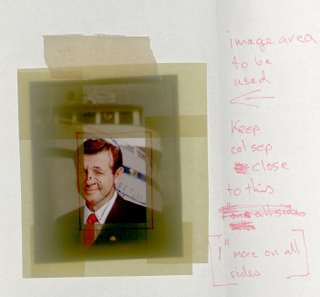
In my files I found two neatly handwritten instructions(by Randy Pearsall) with two masked transparencies of Clarke. In pre digital age transparencies were not scanned but went through a process called colour separation. Here they are. And below a scan of my useful and somewhat used Arca Swiss tripod head that started all this.

Addendum:
name: Randy
comments: I don't want to take up your time on the phone again, but
you mentioned I still have a full head of red hair. Sorry to
say it's only red on the edges leading to grey and then very
thin on top.
Take care Alex
Civics & Civility At City Hall With Sam Sullivan
Tuesday, September 23, 2008
I consider myself to be lucky to be
Sam Sullivan's , friend. A couple of years ago he came to an opening of a show of mine and I introduced him to my granddaughter Rebecca. "Rebecca this is the big cheese in Vancouver." Sullivan retorted, "People do what I tell them to do and if I ask your grandfather to do 50 pushups right now, he will." Rebecca was impressed but her opinion and my opinion of our mayor was clouded by differing ones from some of her other relatives. It was at that first meeting with Rebecca that Sullivan mentioned to her face that she reminded him of a Botticelli portrait.
With Sam Sullivan's waning days as mayor I had the idea that going to city hall with Rebecca and our friend
Abraham Rogatnick (a friend and unofficial adviser to Sullivan) and visit him at his office would offer Rebecca and excellent lesson in civics.
When I was 16 I had one teacher at St. Edward's High School (a Roman Catholic boarding school in Austin, Texas) who was not a Brother of the Holy Cross. He was our baseball coach and his name was Forrest Wright. He had flaming red hair and we had a great respect for him. Part of this respect came from seeing his face match the colour of his hair when he got angry. Not that he ever did. We just knew. Besides teaching us English he taught us civics. I remember him explaining the difference between a felony and a misdemeanor and going into great detail on the difference between first degree murder and second degree murder. I learned a lot in his class. I felt in the last few weeks that Rebecca was perhaps ready for a jolt of civics. I should have known better and taken myself as an example.
When I was 15 our freshman class took to a trip (in a rented Greyhound Scenicruiser) to Washington DC. We visited the Capitol and had a chat with our Texas senator. The large man with very big ears shook each of our hands and gave us advice on being good citizens. He gave us each a card, signed by him, that certified we had been present at a US Senate proceeding. The moment I was outside I chucked the card, signed by Lyndon B. Johnson into the pavement. That's what I though of politics. They were a bore. Being four years older than Rebecca I should have thought twice about my idea of going to city hall.
In the time that Sam Sullivan has been mayor, while being my friend, I have never lobbied for any favours or special privileges. Except for this time when I emailed Anna Luccarino, the mayor's assistant requesting an audience with the mayor. The response to my request was quick and we were given an appointment for yesterday at 3:30.
Besides our audience with Sullivan, Rogatnick was going to give Rebecca a quick tour and explanation of Art Deco. I mentioned to Rebecca the beautiful elevators that would take us to the mayor's office.
Outside the mayor's office we met up with Rogatnick. "Abraham," said Rebecca, "You and Obama have something in common." "What's that asked Rogatnick?" "Both of you went to Harvard, "explained Rebecca. "There is a difference between us"," insisted Rogatnick. "What's that?" Rebecca asked. "He has one degree from Harvard and I have two."
We were ushered into Sullivan's office and the mayor was warm and friendly. I took my photograph of the three with window lighting with my camera on a tripod. The office had changed since the last time I had been there. There was no more desk. Vancouver mayors in the past have sat behind this imposing desk at the end of the room. In small sort of like having an audience with Benito Mussolini. Sullivan did away with the desk and placed a long table instead. We sat down and Rogatnick removed a pile of books on Art Deco from a plastic bag. "I went to the library to find these." By that point Rebecca was using body language to reflect her boredom. There was a lot of open-mouth yawning. Rogatnick explained the Art Deco obsession with sky scrapers and the Empire State Building. He told us that City Hall looks exactly like a truncated Empire State Building. This I was able to confirm when we left and looked back on City Hall from 12th Avenue. He told us of the symbolism of rising suns, steam ships, airplanes and dirigibles.
Rebecca wanted to see the clothing of the period. We found out that the exquisite shoes of the Art Deco age where a result of the paving of streets the advent of cars. There was no more mud. There were no more horse droppings to soil people's feet. That is why they had worn ankle boots. The short skirts were a protest to the long dresses (you must not gaze on my ankles!) of the Victorian age. At this point Rebecca said, "And they strapped their breasts so they would look flat chested." And then she added, "I don't wear dresses. My friends don't wear dresses. My mom does sometimes." Rogatnick tried again. "This is a cloche hat. Women in the 20s wore them. Cloche means bell in French." She yawned.
While this was going on Sullivan was looking in my direction. He seemed to understand my comment, "Abraham we are going through temporary dark ages. We will have a Renaissance some time soon." Abraham countered with, "I love to teach but I expect my students to pay attention."
Sullivan offered Rebecca a moon cake. When Rebecca saw that the packaging was Chinese she said, "It is probably poison." I whispered in her ear, "Take it anyway and then you can throw it away at home." I added, out loud, "Perhaps your mother who loves sweets will eat them." Rebecca firmly and loudly said, "She won't." Sullivan then suggested (in jest), "Rebecca offer them to your friends and watch them. If they survive then it's all right for you to eat them." By this point I wanted to hide under the table. Sullivan whispered in his inimitable way, "One day you will impress people with your knowledge of Art Deco."
From the mayor's office Sullivan took us to the Council Chambers. It was locked and dark. Sullivan had it opened and the lights were turned on. He instructed the attendant to ring the bell under the doorway. Rogatnick pointed out the Art Deco ornaments on the doors and around the room. Sullivan explained to Rebecca how democracy worked in the room and how decisions were made. Rebecca yawned.
We managed to leave with some sort of decorum while I thought that the lesson to be learned came mostly from our Mayor. Civics is important but civility perhaps more. And Mayor Sam Sullivan has it in spades. I will never forget that and his kindness towards Rebecca.
Perhaps not. "Do you understand that Abraham went to the library to get all those heavy books for you?" I told Rebecca on the bus home. "They weren't that heavy," she answered back.
And Abraham Rogatnick? "I don't know why I am laughing. This is serious," he said over the phone when we talked this morning. But Rebecca did learn something". At the dinner table she said, "I know what a cloche hat is."
And Sam, I appreciate what you did and I am sure that someday, Rebecca who was born, in this your city and her city, will come to understand and will be perfectly thrilled that you gave her that opportunity to get a glimpse of civics and civility.






















